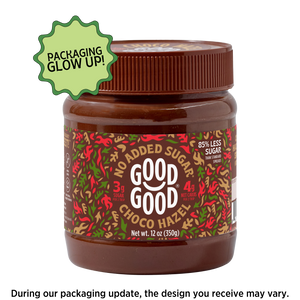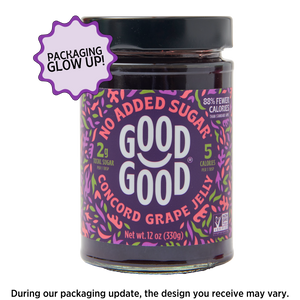Have you ever paused with a spoonful of fig jam close to your lips and wondered, "Is fig jam healthy?"
Fig jam is a delicious spread that can as healthy as it is delicious.
With GOOD GOOD's help, you can also share our passion for crafting and indulging in delectable products that boast a healthy fruit jam profile, like fig jam.
Let's dig in!
What this article covers:- Useful Properties of Fig Jam
- Is Fig Jam Good for You?
- How to Make Healthy Fig Jam
- Going Beyond Just Figs
Useful Properties of Fig Jam
Belonging to the same family as mulberries, the fig is among one of the oldest fruits. They hold a significant place in both culinary and medicinal traditions across various cultures. Cultivated for over 7,000 years, figs have been utilized as an alternative food source during times of famine and war due to their ability to be stored for extended periods without spoiling. And then, a brilliant concept emerged: capturing all that delightful fig goodness in a jam jar. Quite sweet, wouldn't you agree?
When you spread fig jam on your toast, you're not just indulging in a sweet treat; you're also benefiting from the natural goodness of figs. But what makes fig jam stand out?
Unique Composition and Health Benefits of Figs
Figs are a reservoir of numerous vitamins, minerals, and antioxidants.
Fig jam offers a host of health benefits, including aiding digestion (thanks to the fiber content of figs) and giving you a quick energy boost due to its natural sugar content. Other potential health benefits include:
Less Cholesterol and Fat
Unlike nut butters, Nutella and cheese which we spread over toast, which contains high levels of cholesterol and fat, fig jam doesn't contribute to the body's cholesterol and fat content. It is cholesterol free and has less fat content because it is made from fruit. In fact, GOOD GOOD fig jam contains zero grams total fat.
Improve Hair, Skin and Fingernail Health
There is a something called pectin present in figs as well as all fruit. Pectin promotes cell renewal and as some sources cite, improves the health of your hair, skin, and fingernails. Some nutritionist's claim that pectin also plays a role in decreasing blood pressure and the forming of red blood cells in the body.
Natural Sugar vs Added Sugars
While many traditional jams contain lots of added sugars for preservation and taste, GOOD GOOD's fig jam uses high fruit content as a primary source of natural sweetness that reduces the need for excessive added sugars. Containing a whopping 70% real fruits.
This gives our fig jam an edge, making it a healthier alternative for anyone looking to reduce their refined sugar intake.
Is Fig Jam Good for You?
With all the nutritional buzz around fig jam, it's essential to understand whether fig jam is good for you and how it stacks up against other jams. This leads us to ponder, "Are jams healthy?", particularly the fig variant.
Analyzing the Nutritional Content
The nutritional profile of fig jam offers a more natural and balanced sugar content thanks to the inherent sweetness of figs. This means fewer sugar spikes and a more sustained release of energy. Furthermore, GOOD GOOD uses a unique ingredient called organic rowanberry extract to elevate the flavor without needing added sugar.
What is Organic Rowanberry Extract?
Organic rowanberry extract is a natural substance derived from the berries of the rowan tree (Sorbus aucuparia), which is also known as the mountain ash or European mountain ash. Rowanberries are small red or orange fruits that grow on these trees and are often used in various culinary and herbal applications.
Organic rowanberry extract is typically produced by processing the berries through methods such as cold pressing or maceration, which involves soaking the berries in a solvent (usually alcohol or oil) to extract their beneficial compounds. This extract contains a variety of bioactive compounds, including vitamins, minerals, antioxidants, and potentially other phytochemicals that are present in the berries.
Comparison with Other Fruit Jams
While fruits like strawberries or blueberries have their health benefits, their jams often require more added sugars to achieve the desired sweetness level. In contrast, fig jam in some cases requires fewer additives, making it a relatively healthier choice.

The Health Benefits of GOOD GOOD Fig Jam
Fig jam holds a unique and naturally sweet spot with its delightful taste and array of potential health benefits.
Here is a list of potential health benefits of consuming fig jams based on the nutritional profile.
1. Low-Calorie Option: Fig jam contains only 10 calories per serving, making it a low-calorie choice that can be incorporated into a balanced diet. Low-calorie options are beneficial for weight management and overall calorie control.
2. Source of Dietary Fiber: Figs are a good source of dietary fiber, which promotes digestive health and can help prevent constipation. The carbohydrate content per serving may include dietary fiber, which contributes to improved digestion and gut health.
3. Naturally Occurring Sugars: The 2 grams of naturally occurring sugars per serving in fig jam provide a source of quick energy. These natural sugars, along with dietary fiber, can help prevent rapid spikes in blood sugar levels when consumed as part of a balanced meal or snack.
4. Rich in Antioxidants: Figs are rich in antioxidants, including polyphenols and flavonoids, which help combat oxidative stress and reduce inflammation in the body. These compounds have been associated with a reduced risk of chronic diseases like heart disease and certain cancers.
5. Micronutrient Content: Figs are a source of essential vitamins and minerals, including potassium, calcium, and magnesium. Potassium, in particular, supports heart health by helping to regulate blood pressure and maintain proper fluid balance in the body.
6. Potential Gut Health Benefits: The dietary fiber in figs may promote a healthy gut microbiome. A diverse and balanced gut microbiome is associated with various aspects of overall health, including immune function and even mental well-being.
It's important to note that while these potential health benefits are supported by scientific understanding of the nutrients found in figs, jams may vary. Additionally, moderation is key, as excessive consumption of even healthy foods can lead to unintended consequences. Always consult a healthcare professional or registered dietitian for personalized advice on incorporating specific foods into your diet.
How to Make Healthy Fig Jam
Making fig jam at home means you can enjoy its natural benefits without any unwanted additives.
Ingredients
To make a delectable but healthy fig jam at home, you'll need:
- 10-12 fresh figs
- 1 tsp of lemon juice (natural preservative)
- Alternate sugars like honey or agave (based on your personal preferences). Vanilla sweet drops or keto pancake syrup also work well.
- 1/4 cup of water
You can also add optional boosters to the mix, like:
- Chia seeds (for added fiber and a thicker consistency)
- Ginger or cinnamon (for a flavor kick and added antioxidants)
Instructions
Start by washing and quartering your figs, ensuring you remove the stems.
Place the figs in a large pot, and add the lemon juice and water. The lemon juice preserves the color and adds a natural pectin boost.
Bring the mixture to a boil, then reduce it to a simmer. Let it cook for 30-40 minutes, stirring occasionally. As the figs break down, they'll release their natural sugars, which will thicken the jam.
Once the figs are soft and cooked through, use a potato masher for a chunky texture or an immersion blender for a smoother consistency.
To ensure the fig jam has set, place a spoonful of it on a cold plate. If it wrinkles when you push it, it's ready.
Our Sweet Serving Suggestions
Homemade fig jam is versatile. Spread it on whole grain toast, swirl it into oatmeal, or use it as a sweetener in savory dishes. The rich, natural sweetness of figs pairs well with cheeses, making it an excellent addition to charcuterie boards.
Storing
To ensure the longevity and preservation of nutrients in your fig jam, store it in a sterilized jar in the refrigerator.
Let the fig jam cool to room temperature before transferring it to a sterilized jar, then store it in the refrigerator for 2-3 weeks. If you want it to last a little longer, you can also freeze it for up to six months.
Going Beyond Just Figs
While fig jam is a delightful addition to the breakfast table or a midday snack, why limit yourself? GOOD GOOD proudly offers a range of no added sugar spreads - from our sugar free jelly to hearty and crunch peanut butter, crafted with health-conscious consumers in mind.

But the fun doesn't stop there!
- Quick Breakfast Ideas: Incorporate our no sugar added crunchy peanut butter on whole-grain toast for a protein punch, or blend our creamy no sugar added peanut butter into smoothies for a creamy texture and nutty flavor.
- Snack Hacks: Kids love our 99% sugar free grape jelly spread on rice cakes, while adults appreciate the sophisticated taste of our keto-friendly orange marmalade paired with cheese or yogurt.
- Perfect Pairings: Our exploration into food pairings revealed that our sugar free lemon curd beautifully complements baked goods, while our rich chocolate spreads like Choco Hazel and Choco Orange go great with fruits, creating a taste and health synergy.
Conclusion
Fig jam isn't just healthy but also a delightful way to introduce the benefits of figs into your diet.
With a plethora of options like our low carb peanut butter, delicious jams, and indulgent chocolate spreads, GOOD GOOD is committed to ensuring your spread choices are both tasty and healthy.
Our dedication lies in creating products with no added sugars, ideal for the discerning, health-conscious American family. As you strive to strike a balance between taste and health, let us accompany you on this journey.
So, why not treat yourself and your tastebuds to our delectable range of no sugar added jams and explore the burst of healthy flavors firsthand today?
If you want to learn more, why not check out these articles below:
- Is Peanut Butter and Jelly Healthy?
- Is Toast and Jelly Healthy?
- Jelly vs Jam vs Preserves Healthier Comparison
- Is Jelly Healthy?
- Is Grape Jelly Healthy?
- Healthy Jelly for Toddlers
Note: This blog post is only informational and should not replace professional medical or nutritional advice. Consult with a healthcare professional or registered dietitian for personalized guidance.





![[title] Reforestation Donation by Dollar Donation Club sold by US GOOD GOOD®](http://goodgoodbrand.com/cdn/shop/files/DollarDonationClubShopify_1_300x.jpg?v=1712681952)













